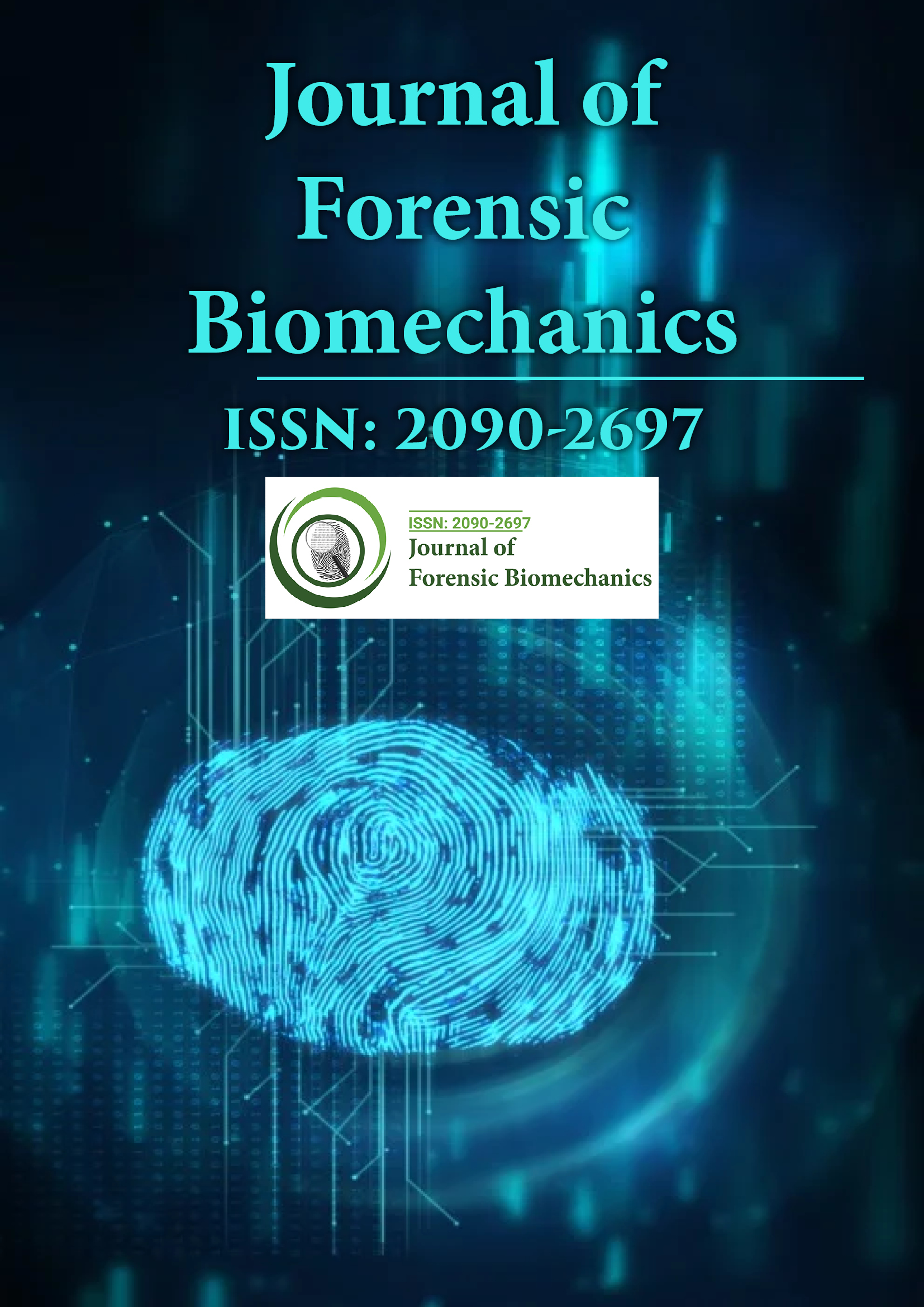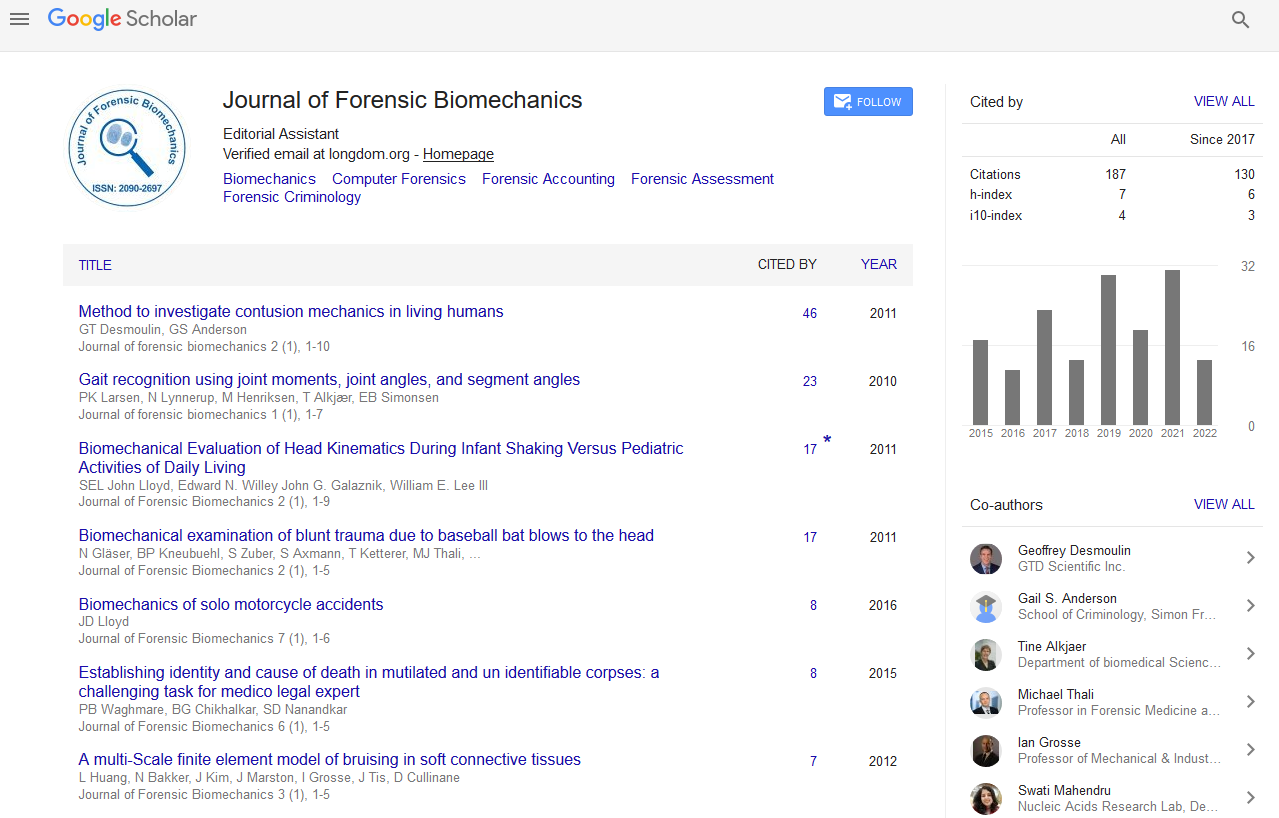Indexed In
- Genamics JournalSeek
- SafetyLit
- Ulrich's Periodicals Directory
- RefSeek
- Hamdard University
- EBSCO A-Z
- Geneva Foundation for Medical Education and Research
- Euro Pub
- Google Scholar
Useful Links
Share This Page
Journal Flyer

Open Access Journals
- Agri and Aquaculture
- Biochemistry
- Bioinformatics & Systems Biology
- Business & Management
- Chemistry
- Clinical Sciences
- Engineering
- Food & Nutrition
- General Science
- Genetics & Molecular Biology
- Immunology & Microbiology
- Medical Sciences
- Neuroscience & Psychology
- Nursing & Health Care
- Pharmaceutical Sciences
Opinion Article - (2024) Volume 15, Issue 2
The Interaction of Biomechanics and Forensic Anthropology in Determining Cause of Death
David Vos*Received: 01-Jul-2024, Manuscript No. JFB-24-26587; Editor assigned: 04-Jul-2024, Pre QC No. JFB-24-26587 (PQ); Reviewed: 18-Jul-2024, QC No. JFB-24-26587; Revised: 25-Jul-2024, Manuscript No. JFB-24-26587 (R); Published: 01-Aug-2024, DOI: 10.35248/2090-2697.24.15.487
Description
In the jurisdiction of forensic science, the determination of cause of death is a complex process that often requires the integration of multiple scientific disciplines. Among these, biomechanics and forensic anthropology play pivotal roles. The interplay between these fields enhances our understanding of strain mechanisms and helps establish definitive cause-of-death conclusions in forensic investigations.
Biomechanics in forensic science
Biomechanics, the study of the mechanical principles of living organisms, is essential in forensic science for analyzing the forces involved in traumatic injuries. It applies principles of physics and engineering to understand how forces impact the human body, which is essential for reconstructing the circumstances of injuries. In forensic investigations, biomechanics can help determine the nature of trauma, such as whether injuries were caused by blunt force, sharp force, or ballistic impact. By evaluating factors such as the direction, magnitude, and point of impact, biomechanical analysis provides insights into the mechanism of injury. For instance, in cases of blunt force trauma, biomechanical models can help determine the force required to cause specific injuries, such as fractures or contusions. This understanding is critical in distinguishing between accidental injuries, self-inflicted harm, and deliberate attacks.
Furthermore, biomechanics contributes to understanding how various types of trauma can interact with pre-existing medical conditions. For example, an individual with osteoporosis may sustain fractures from lower-impact forces that would not affect a healthy bone. This nuanced understanding helps forensic experts differentiate between injuries resulting from natural causes and those inflicted by external forces.
Forensic anthropology in death investigation
Forensic anthropology focuses on the study of human skeletal remains to determine age, sex, ancestry, and stature of individuals, as well as to identify trauma and pathological conditions. Anthropologists analyze bone structures and modifications to draw conclusions about the deceased's life and death. One of the key contributions of forensic anthropology is the identification of skeletal trauma patterns. Forensic anthropologists examine fractures, dislocations, and other skeletal changes to identify the type of force and its likely source. For example, specific patterns of bone breakage can indicate whether an injury resulted from a fall, a vehicular accident, or a physical assault. Additionally, forensic anthropology helps in differentiating between per mortem (around the time of death) and post-mortem injuries. Per mortem injuries are typically characterized by their sharp, clean edges and lack of healing, whereas post-mortem injuries often show signs of weathering and deterioration. This distinction is fundamental for establishing whether injuries occurred before or after death, which has significant implications for determining the cause of death.
Integration of biomechanics and forensic anthropology
The integration of biomechanics and forensic anthropology creates a comprehensive approach to understanding traumatic injuries and determining cause of death. By combining biomechanical models with anthropological analysis, forensic experts can reconstruct events with greater accuracy. For instance, if an anthropologist identifies a specific fracture pattern on skeletal remains, a biomechanics can use this information to simulate the forces that might have caused the injuries. This collaborative approach helps establish the likelihood of different scenarios, such as whether a fracture occurred from a fall or a violent impact. Moreover, biomechanical models can aid forensic anthropologists in interpreting complex cases. For example, in instances where skeletal remains exhibit multiple types of injuries, biomechanics can help prioritize the analysis of certain injuries based on their mechanical plausibility. This ensures that forensic anthropologists focus on the most critical aspects of the suffering for determining cause of death.
Citation: Vos D (2024) The Interaction of Biomechanics and Forensic Anthropology in Determining Cause of Death. J Forensic Biomech. 15:487.
Copyright: © 2024 Vos D. This is an open-access article distributed under the terms of the Creative Commons Attribution License, which permits unrestricted use, distribution, and reproduction in any medium, provided the original author and source are credited.

